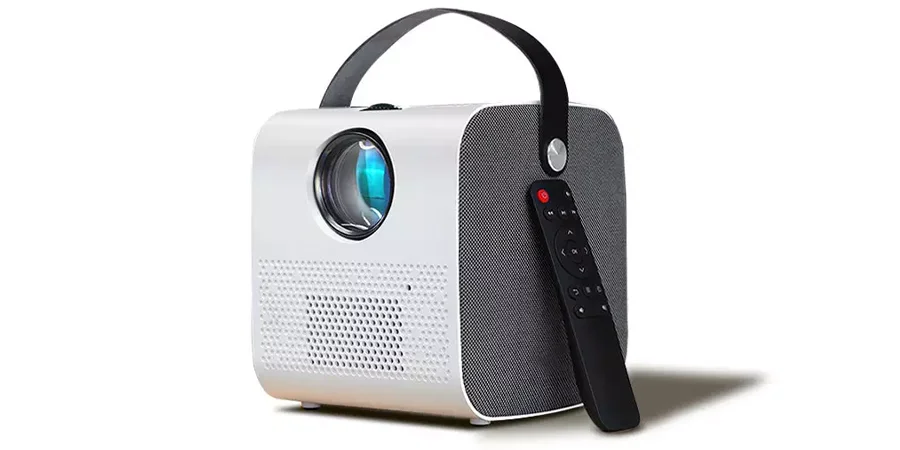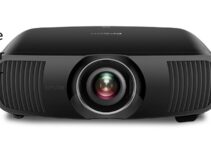Have you ever wanted to watch movies outdoors with your friends? Looking for a way to present an idea in a boardroom but can’t find an easy way? Look no further!
Get the ease of projection on-the-go with portable projectors. Whether you want to show off your next adventure or present your idea, these projectors will be your perfect companion. Discover the best projection experience with this complete guide now!
Projectors can be used in many environments, from home theater set ups to professional office spaces. However, for situations that require setting up a projection quickly and conveniently, portable projectors are the ideal tool. Whether you need a quick setup for an outdoor meeting or a business presentation at an offsite location, these devices provide convenience and flexibility.
In this guide we take a look at the features of portable projectors and what different features to look for when picking out the right one for your needs. We’ll also discuss installation tips and how to select the best projector model given various projection quality requirements. Finally, we provide tips on using your projector safely while on-the-go and some helpful maintenance tips over its lifetime of use. We hope you find this guide useful in finding the right portable projector that suits all your needs!
Explanation of the topic
For many, part of the appeal of exploring new places is sharing their experiences with others. But not everyone can physically join you on your adventures. One way to take your storytelling to the next level is by using a portable projector on your travels to bring your stories to life wherever you go.
Whether you’re looking for a tool that will help capture stunning outdoor cinematography or wanting to keep friends and family up-to-date with all the amazing destinations around the world, a portable projector could be a great addition to any adventurer’s toolkit. This guide will provide an overview of what portable projectors are, describe their advantages and disadvantages, review some factors often-considered when purchasing one, and discuss accessories available for enhancing the user experience.

Understanding Portable Projectors
When looking for a portable projector, it’s important to understand certain specs and features. The most important specs to consider when selecting the best portable projector for your needs are:
Brightness: Brightness is measured in lumens and the brighter the better. Portable projectors range from 100 to 500 lumens, so make sure you get one that is bright enough to meet your needs. You may need more lumens if you plan on using your projector in dimly lit or outdoor settings.
Contrast ratio: The contrast ratio determines the quality of color and clarity projected, with a higher ratio meaning richer colors and better image quality. Most portable projectors have low contrast ratios ranging from 200:1-500:1. However, some projectors boast high contrast ratios at 2000:1 for higher quality images.
Display technology: Display technology will determine which type of video signals your device can accept and reproduce on-screen. The two most common technologies being LCD (Liquid Crystal Display) or DLP (Digital Light Processing). LCD projects an image onto a screen via liquid crystal display panels, while DLP uses a light source or bulb that emits light on to tiny mirrors that project pixels of light onto your screen.
Among these factors, brightness is usually the most important one that must meet your need specifically; other qualities may be less relevant if you are working with limited space or budget constraints as long as image quality meets baseline requirements. Weigh all these factors carefully before choosing which product is right for you!
What is a portable projector?
A portable projector is a device that can be used to project images and videos from a laptop, DVD player, gaming device, or other output device onto another surface like a wall or a screen. Portable projectors are typically compact and lightweight, designed for easy setup and portability. They can be powered by batteries or through power cords and require little setup to start projecting.
Portable projectors are often used in homes, classrooms and boardrooms to present content in ways that facilitate learning or communication despite social distancing protocols. By choosing a portable projector equipped with Wi-Fi connectivity options, it’s also easy to create presentations from mobile devices.
Whether you need something with vivid color reproduction for business presentations or simple compatibility with game consoles for movie nights outdoors, there are several options available for on-the-go projection that fit your needs.
Benefits of using a portable projector
Portable projectors provide a number of advantages over conventional projection setups, making them ideal for holidays, outdoor events, or business presentations. Some of the advantages you can enjoy include:
– Mobility: Most portable projectors weigh less than 5 pounds and can slip easily into a backpack or suitcase, allowing you to take your movie theater or presentation on the road.
– Installs Easily: Setting up a portable projector is generally much simpler than installing more permanent options. Simply connect to your device via HDMI cable, Blu-ray player, laptop, smartphone, or tablet and you’re ready to go.
– High Resolution: With most models offering full HD resolution (1080p), you won’t have to sacrifice picture quality when traveling away from the office or home theatre.
– Economical: Many of these devices are cheaper than their traditional counterparts due to their compact size and light weight design.
– Versatility: Some models feature HDMI splitters that allow multiple users to share the same input at once so they can all view content simultaneously with no compromise in quality or performance.

Factors to Consider When Choosing a Portable Projector
When purchasing a portable projector, there are several features and characteristics to consider. The first factor is lumens, which indicates the level of brightness a projector can produce. A higher lumens rating means that the projector can be used in brighter daylight environments or larger rooms with many windows. Smaller or lower lumen projectors are better suited for dark bedrooms or small offices.
The resolution is also an important factor to keep in mind when selecting a portable projector, as it determines how sharp and clear your images will be when projected on a larger screen. Common resolutions range from SVGA (800×600) to WUXGA (1920×1200). In general, higher resolution projectors create clearer detailed images for display.
In addition, contrast ratio is an important spec to consider as it affects image detail and clarity by determining the level of difference between white and black within the image being displayed on-screen. A wide native aspect ratio ensures that you can fill up more screen space without distorting the picture quality. Inputs and outputs should also be considered as these determine connectivity options available for connecting other devices such as laptops and smartphones.
Portability and size
Staying connected and organized even on the go is a key factor for successful business trips and vacations. Portable projectors come with stunning image quality and advanced features in a more compact size, making them ideal for travelers who need to make presentations or watch movies in different places.
While size and portability are important factors to consider when choosing a projector, other criteria such as brightness, contrast ratio, connectivity and audio/visual outputs should also be taken into account.
When selecting a projector based on size, it’s important to consider your specific needs. If you intend to carry the portable projector around with you frequently, then you may want to prioritize products that are lightweight with built-in handles or straps for convenient transportation. If storage volume is an issue when packing space is limited, then smaller models that fit into bags or even jeans pockets might be a better option. Also look for models that feature foldable stands or tripod mounts – as these allow for easy setup and breakdown so you can save time when setting up and packing away after use.
Brightness and resolution
When shopping for a projector, it’s important to first consider the brightness and resolution. Brightness is measured in lumens (lm) and tells you how bright the projector can be. This number can range from 50 to 5000 or more lumens depending on the size of your room and how bright you need the projector to be. If your room is small and dark, then you won’t need a projector with a high lumen count. However, if you are projecting in a large room with other light sources like windows that let in natural light, then you may want to opt for a higher lumen count.
The resolution is also an important factor as it will determine how sharp the image on screen will be. Most projectors are capable of 1080p resolution which will give you crystal clear images with no blurring, but if you are looking for an even sharper definition then there are some projectors that can go up to 4K resolution. The prices will rise with each increase in quality, so decide on how much detail you actually need before investing in a higher resolution model.
Connectivity options
When looking for a portable projector, it’s important to consider the various forms of connectivity. The most common are wireless, HDMI, and USB.
Wireless: With this type of connection, you can stream content from your laptop or phone directly to the projector without needing cables. Most models come equipped with Google Chromecast, allowing you to easily connect Chromecast-enabled devices to the projector via Wi-Fi. Some models also support Apple Airplay and Miracast technologies.
HDMI: This connection allows you to connect your laptops and set-top boxes as well as projectors supporting UHD/4K resolution videos quickly and easily. Not only can you transfer large amounts of high-quality data this way, but also experience lag-free playback on larger screens since both HDMI inputs and outputs are supported by many portable projectors today.
USB: Through USB connectivity with projectors, users can display content stored on their pen drives and USB disks as well as any document format directly from a laptop’s hard drive on bigger screens in no time. This feature also makes it easy for users to transfer work files between computers without having to use external storage devices or an internet connection.This means that even those who don’t have access to wireless networks won’t be left out of the viewing experience!

Conclusion
After exploring the vast array of options available for portable projectors, it’s clear that there is something for everyone. From the budget-conscious consumer to the tech enthusiast, portable projectors offer a great way to enjoy big screen entertainment without needing expensive hardware. Whether you’re watching movies in your backyard or playing video games in a park, there is an ideal portable projector suited to your needs.
With great features like long battery life, native display compatibility with both PCs and mobile devices, and simple setup, these projectors are an ideal choice for on-the-go entertainment. Additionally, many companies have added features and functionality such as multiple connectivity ports, built-in speakers and strong software support. With better projection quality than ever before at reasonable prices across various models and makers, your search should be relatively stress free!
FAQs
Which is best portable projector?
The best portable projector depends on the specific needs of the user, as different projectors offer different features and specifications. Some top models include the Anker Nebula Capsule II, LG PH550, and ViewSonic M1+.
What is the advantage of portable projector?
The advantages of a portable projector include easy portability, allowing users to take the projector on the go and set it up quickly, and versatility, as portable projectors can be used for a variety of applications.
Is there a projector that will play Netflix?
Yes, many projectors are capable of playing Netflix when connected to a device that has the Netflix app, such as a laptop or streaming device.
What is the best projector for outdoor daytime viewing?
The best projector for outdoor daytime viewing should be bright enough to overcome ambient light and have a high contrast ratio. Some top models include the Epson Home Cinema 3800, Optoma GT1080Darbee, and BenQ TH671ST.
Is it OK to use a projector for everyday?
Yes, it is okay to use a projector for everyday, as long as the projector is properly maintained and used in accordance with the manufacturer’s instructions.
Is it good to buy a projector?
It can be good to buy a projector, as they offer a large screen size and immersive viewing experience, as well as versatility in terms of use. However, it depends on the specific needs and preferences of the user.
What are the main uses of projector?
The main uses of a projector include home theater, presentations, education, gaming, and professional use, such as in architecture or engineering.
What is the most important feature of a projector?
The most important feature of a projector depends on the specific needs of the user, but generally includes factors such as brightness, resolution, and contrast ratio.
What are the features of projector?
Features of a projector can include brightness, resolution, contrast ratio, throw distance, zoom, keystone correction, and lens shift.
What is the price of Netflix projector?
There is no specific price for a “Netflix projector,” as any projector can play Netflix as long as it is connected to a device with the Netflix app. The price of a projector depends on its specific features and specifications.
See Also:
- Best bluetooth projectors
- Best projectors for artists
- Best projectors for bright rooms
- Best projectors for golf simulators
- Best projectors for daylight

